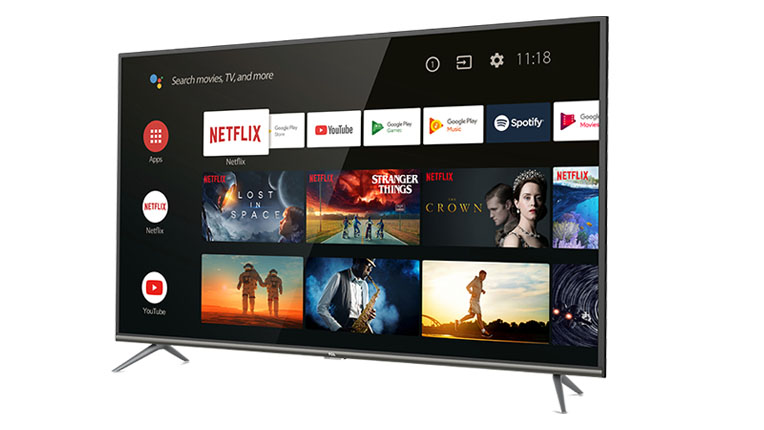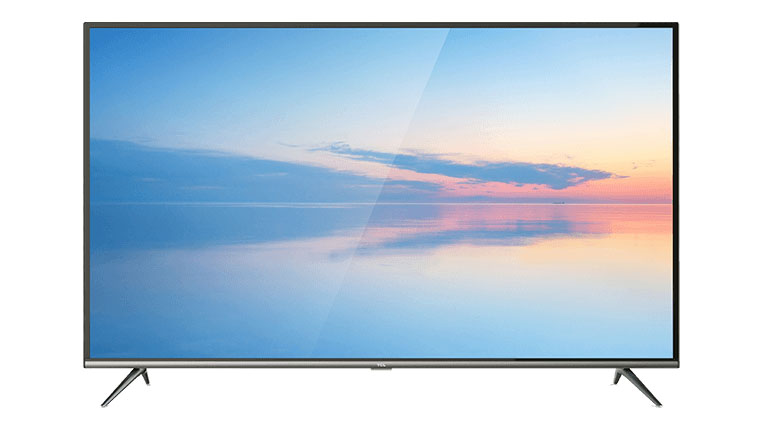TCL EP658 (43EP658) review: Impressive 4K picture quality?
The TCL EP658 impresses with a decent spec for the money but audio syncing issues cause trouble

The TCL EP658 impresses in many ways, but when it comes up short it comes up very short indeed.
-
+
Decent spec for the money
-
+
Very watchable with native 4K content
-
+
Android TV interface
-
-
Substandard upscaling
-
-
Audio/video syncing travails
-
-
Inconsistent backlighting
Why you can trust T3

Welcome to T3's TCL EP658 review. TCL is the second-largest electronics company in the world (by volume of product shipments), though it's only just starting to make itself known in Europe.
TCL has taken less than 40 years to get this point, so the obvious next step is to try and bring the rest of Europe under its spell in the same way it has beguiled the German and US markets. Its path to that includes well-priced phones, and budget TVs like this EP658 model.
Certainly this 43EP658 would seem to have what it takes to make a splash in our lists of the best 43-inch TVs, and best TVs under £500. An eye-catchingly modest sum buys a specification impressive enough to set the TCL apart from the ‘inexpensive TV from a less well-known brand’ herd.
But seeming competitive on paper of one thing, of course, while being competitive in action is quite another...
TCL EP658 review: Price & features
The TCL EP658 is one of several TCL model ranges, and it seems the company considers it the price/performance sweet spot. Available in four screen sizes – this £329 43-inch is the smallest, and it can also be yours in 50-inch (£379), 55-inch (£479) and 65-inch (£599) versions – it has most of what you’d consider necessary to compete at its price-point.
First and foremost, this is a 4K screen with a native resolution of 3840 x 2160. It includes HDR for both broadcaster-friendly HLG and HDR10 standards, but there’s no HDR10+ or Dolby Vision dynamic metadata support, which is now appearing on more budget TVs.
It’s an LCD panel, using direct LED backlighting with local contrast adjustment. And its operating system and Smart TV interface is Android TV-based, which promises both a thorough and a straightforward experience.
Get all the latest news, reviews, deals and buying guides on gorgeous tech, home and active products from the T3 experts
In terms of connectivity, the EP658 is okay. It’s equipped with a couple of HDMI 2.0 inputs (one of which is HDMI ARC enabled, for adding one of the best soundbars), a USB input, an Ethernet socket (as well as dual-band Wi-Fi, naturally), a 3.5mm input for use with a composite video adaptor, a digital optical output and a couple of aerial binding posts for satellite and terrestrial tuners. They’re all stowed in a vertical line where the chassis of the TCL is at its deepest. We'd like three HDMI inputs at this price, really.
Sound is delivered by a couple of downward-firing full-range drivers, powered by a total of 16 watts. That’s an unremarkable driver array, and an unremarkable amount of power with which to drive them – so in this respect, the TCL is specified exactly as you’d expect a screen at this sort of money to be.

TCL EP658 review: Picture performance
The pictures the TCL serves up fall into two quite distinct camps: native 4K content and the lower-resolution stuff the EP658 has to upscale.
If you only saw the EP658 delivering native 4K content, there’s every chance you’d a) be mightily impressed and b) wonder if the price wasn’t a misprint. It doesn’t matter if it’s showing the high-bandwidth of a 4K UHD Blu-ray disc or a 4K Netflix stream, the TCL gets pretty much everything, picture-wise, right.
Despite a peak brightness of only 300 nits or so, the 658 manages to muster quite striking white tones, and invests them with plenty of detail at the same time. It is able to combine these with quite deep, lustrous and equally nicely detailed black tones, so even the most glaring contrasts in a single scene are properly described.
It does equally good work with colours – it paints from a wide-ranging and convincing palette. And there is proper insight into textures, worthwhile control of motion and stable, coherent description of even quite tricky patterns. Edges are drawn smoothly, there’s passable depth of field to images, and skin-tones are as natural and believable as any TV at this sort of money can muster.
Watching movies in 21:9 aspect ratio, with its black bars at the top and bottom of the screen, does reveal some inconsistencies in the TCL’s backlighting, however. But these turn out to be pretty minor in comparison with the difficulties the EP658 has in upscaling lower-resolution content to fit its pixel-count.
Even a ‘best of the rest’ 1080p Blu-ray suffers quite badly. Detail levels fall away, to be replaced by unwelcome smoothness, and the edges the TCL drew so confidently with 4K stuff become a little restless and uneven. Picture noise makes its way into scenes with a lot of colour uniformity, and black tones have a lot of their detail crushed out of them.
These traits become increasingly pronounced the more the native resolution of the content is reduced: DVD is noisy, short of fine detail and provokes the TCL into a fit of what used to be called ‘the vapours’ every time a mildly complicated pattern appears. Motion-tracking lacks certainty, to the point that edge-doubling is occasionally discernible.
Gallingly, it’s possible to add to these woes by selecting ‘smart HDR’ from the TCL’s selection of picture preset modes. Intended to bring a little of the colour volume and contrast width of HDR content to SDR material, instead it seems to put a rocket up every one of the EP658’s 300-odd nits until white tones are seared clean of all detail. And in scenes that include a lot of bright white to begin with, ‘smart HDR’ can provoke some mild, but definite, strobing.
Still, it’s easy enough to leave ‘smart HDR’ alone. What seem unavoidable are the TCL’s difficulties in keeping audio and video information in sync. It’s not a problem that manifests itself with off-air broadcasts, but both disc-borne content and streams from the internet periodically lose picture/sound synchronisation. If your disc player has audio delay adjustment it’s possible to overcome this, but that’s not the case when streaming from Netflix, Amazon or any of the other services.
It takes hardly any delay between on-screen action and the accompanying sound to make the whole viewing experience artificial and frustrating, and ‘hardly any delay’ is what the EP658 serves up with annoying frequency.

TCL EP658 review: Sound quality
Putting the audio/video syncing issues to one side for a moment (which isn’t easy), the TCL is actually a fairly well-judged listen by prevailing standards. There’s some upper-frequency hardness apparent at volume, and a predictable lack of heft at the opposite end, but the midrange projects forward quite nicely and the overall presentation is quite well separated. For all that it lacks dynamism and can let finer details go astray, the EP658 is by no means the sonic disaster many of its nominal competitors are.
TCL EP658 review: Design & usability
You’re not expecting the Earth where the design of your new, budget-conscious TV is concerned, are you? Good. And anyway, the TCL 43EP658 is actually quite a clean looker from dead ahead: the left, right and top bezels are decently slim, smooth and nicely finished in shiny black plastic. And across the bottom, there’s a broader, silver-painted bezel with some ‘TCL’ branding in the centre.
Underneath, the TV stands on a couple of simple silver-painted boomerang-shaped feet. They’re quite far apart, which gives you somewhere to put a soundbar should you so desire – but also means the TV needs a fairly wide surface to stand on if it’s not being wall-mounted.
Putting it up on the wall is pretty easy, as the EP658 accepts a VESA bracket. But it’s a very retro 78mm deep, which may not sound all that much, but makes it look quite chunky when it’s up on the wall.
In terms of usability, the news is almost entirely good. There’s nothing special about the remote control the TCL is supplied with: it feels a bit more downmarket than the TV itself, and its button layout isn’t what you’d call ‘intuitive’. But TCL has developed a very worthwhile control app called T-Cast, which is quite a lot more useful and usable.
And as the cherry on the top, the EP658 both Works with Alexa and is Google Assistant Ready, so if you enjoy getting your own way simply by raising your voice (and you have an appropriate smart speaker on the same network as the TV), go right ahead.
No matter the method you favour when navigating the TCL, its Android TV interface is a logical, comprehensive and straightforward. Yes, it hogs the entire screen, but its breadth of options makes that almost inevitable.

TCL EP658 review: Verdict
There’s no denying the TCL 43EP658 has its moments. Its picture quality with 4K content is truly impressive, its Android TV interface is most agreeable, and its sound quality is superior to that of any number of more expensive alternatives.
But where it falls short, it falls short heavily. Given how humdrum an upscaler it is, and how routinely it suffers from audio/video syncing problems, the TCL turns out to be quite a lot less compelling that it might seem at first glance.
Also consider
If you want a solid alternative for a smidgen more cash then, as you'll see in the live widget below, Samsung's super AU9000 is on offer and while it's not the company's top-tier offering, it's really impressive where it counts.
If you're wondering how we test our TVs here at T3 – or indeed any gadgets, and believe us, we do cover an awful lot – then head over to our How We Test page for the full lowdown on our process and ethics.
Simon Lucas is a freelance technology journalist and consultant, with particular emphasis on the audio/video aspects of home entertainment. Before embracing the carefree life of the freelancer, he was editor of What Hi-Fi? magazine and website – since then, he's written for titles such as Wired, Metro, the Guardian and Stuff, among many others. Should he find himself with a spare moment, Simon likes nothing more than publishing and then quickly deleting tweets about the state of the nation (in general), the state of Aston Villa (in particular) and the state of his partner's cat.
